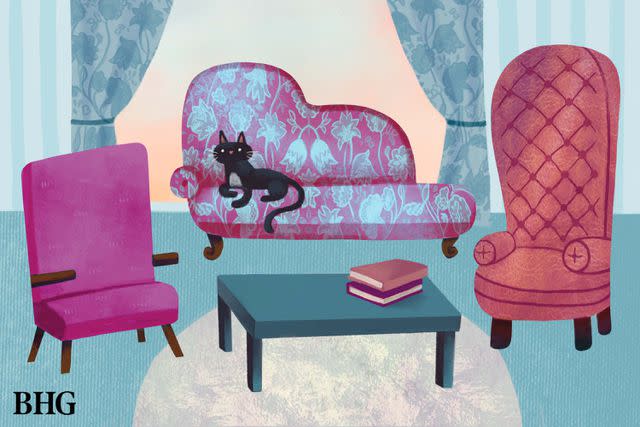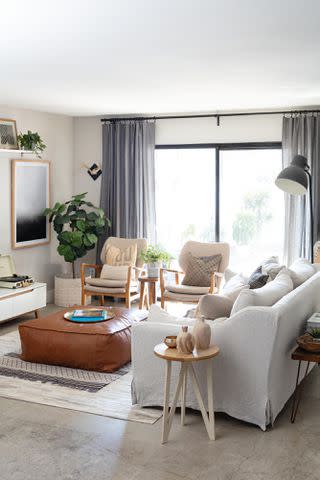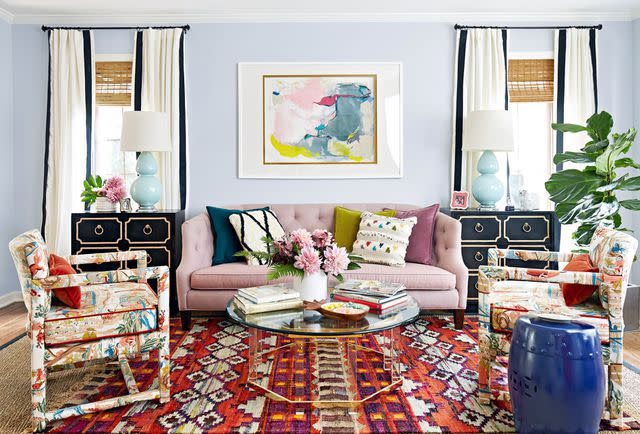How to Pick the Best Upholstery Fabric for Furniture
Learn everything you need to know about durability, cleanability, soil resistance, and fading when choosing a material for your next upholstery project.
No matter how upholstery fabric is used in your home, it must stand up well to the amount of use the furniture gets. For example, sofas, chairs, and ottomans used less frequently, such as those in bedrooms or more formal spaces, will do fine with a more delicate fabric. However, pieces subjected to heavy daily wear, like the family room sofa, should be covered in tough, durable, tightly woven fabrics to protect against stains and damage.

BHG / Nez Riaz
When purchasing upholstery fabric or upholstered furniture, keep in mind that the higher the thread count, the more tightly woven the fabric and the better it will wear. Thread count refers to the number of threads per square inch of fabric. Use this guide to natural and synthetic materials to help you find the best upholstery fabric for your next furniture project.

Natural Upholstery Fabric Types
Natural upholstery fabrics refer to those woven from materials found in nature. This includes plant fibers and materials derived from animal products. Here are some of the most common natural fabrics used on upholstered furniture.
Cotton: This natural fiber resists wear, fading, and pilling. It is less resistant to soiling, wrinkling, and fire. Surface treatments and blending with other fibers often make up for these weaknesses. Durability and use depend on the weave and finish. Damask weaves are formal; canvas (duck and sailcloth) is more casual and durable.
Cotton Blend: Depending on the weave, cotton blends can be sturdy, family-friendly fabrics. A stain-resistant finish, such as Scotchgard Fabric and Upholstery Protector, should be applied to furnishings used daily.
Leather: This rugged material can be gently vacuumed, damp-wiped, and cleaned with leather conditioner or saddle soap.
Linen: Linen is best suited for formal living rooms or adult areas because it soils and wrinkles easily. It also won't withstand heavy wear. However, linen does resist pilling and fading. Soiled linen upholstery should be professionally cleaned to avoid shrinkage.
Silk: This delicate fabric is only suitable for adult areas, such as formal living rooms. It must be professionally cleaned if soiled.
Vinyl: Easy-care and less expensive than leather, vinyl fabrics are ideal for busy living and dining rooms. Durability depends on quality.
Wool: Sturdy and durable, wool and wool blends offer good resistance to pilling, fading, wrinkling, and soil. Generally, wool is blended with a synthetic fiber to make it easier to clean and to reduce the possibility of felting the fibers, where the fibers are bonded together until they resemble felt. Blends can be spot-cleaned when necessary.
Related: A Complete Guide to Upholstery Basics for Easy DIY Projects

Synthetic Upholstery Fabric Types
Synthetic fabrics are manufactured materials designed using chemical processes. They are typically more durable and less expensive than natural upholstery fabrics.
Acetate: Developed as imitation silk, acetate can withstand mildew, pilling, and shrinking. However, it offers only fair resistance to soil and tends to wear, wrinkle, and fade in the sun. It's not a good choice for furniture that will get everyday use.
Acrylic: This synthetic fiber was developed as imitation wool. It resists wear, wrinkling, soiling, and fading. Low-quality acrylic may pill excessively in areas that receive high degrees of abrasion. High-quality acrylics are manufactured to pill significantly less.
Microfiber: Made from polyester, this popular upholstery fabric has a velvet-like texture but is much more durable. It resists water, stains, and fading, so it's great for high-use furnishings.
Nylon: Rarely used alone, nylon is usually blended with other fibers to make it one of the strongest upholstery fabrics. Nylon is very resilient; in a blend, it helps eliminate the crushing of napped fabrics such as velvet. It doesn't readily soil or wrinkle, but it does tend to fade and pill.
Olefin: This is a good choice for furniture that will receive heavy wear. It's highly resistant to stains, mildew, abrasion, and sunlight, so it can be used indoors and outdoors.
Polyester: Rarely used alone in upholstery, polyester is mixed with other fibers to add wrinkle resistance, eliminate crushing of napped fabrics, and reduce fading. When blended with wool, polyester aggravates pilling problems.
Rayon: Developed as an alternative to silk, linen, and cotton, rayon is durable, but it does wrinkle. However, recent developments have made high-quality rayon a practical, family-friendly upholstery fabric.
Related: How to Choose the Perfect Fabric for Your Outdoor Furniture
DIY Upholstery
Recovering old furniture with new fabric can completely transform the look and functionality of the piece. While reupholstering an item yourself can save you hundreds of dollars, the process can be a little tricky. You should check that the piece's structure is in good shape before you begin. Be sure to choose a fabric that's easy to work with and appropriate for the piece's level of use. When you're ready to reupholster, remove the old fabric and use it as a guide for the size and shape of the new fabric pieces.
Here are some guides to reupholstering to help you with your projects.
Frequently Asked Questions
Where can you buy upholstery fabric?
You can buy upholstery fabric at a fabric store, either locally or online. Many upholsterers have fabric swatches or books that you can look through as well.
What is upholstery fabric?
Upholstery fabric is a fabric made for covering furniture. It's generally heavier and more durable than most fabrics used for clothing or bedding.
What is the most durable fabric for upholstery?
That depends on what you're upholstering and what the furniture will be used for. A heavy-duty synthetic microfiber will be the most stain-resistant and easiest to care for, so it's an excellent choice for often-used sofas or chairs. Still, high-thread-count cotton will have enough durability for less-frequently used seating in a formal dining space.
For more Better Homes & Gardens news, make sure to sign up for our newsletter!
Read the original article on Better Homes & Gardens.